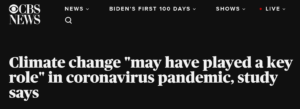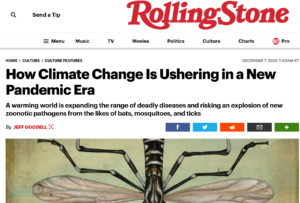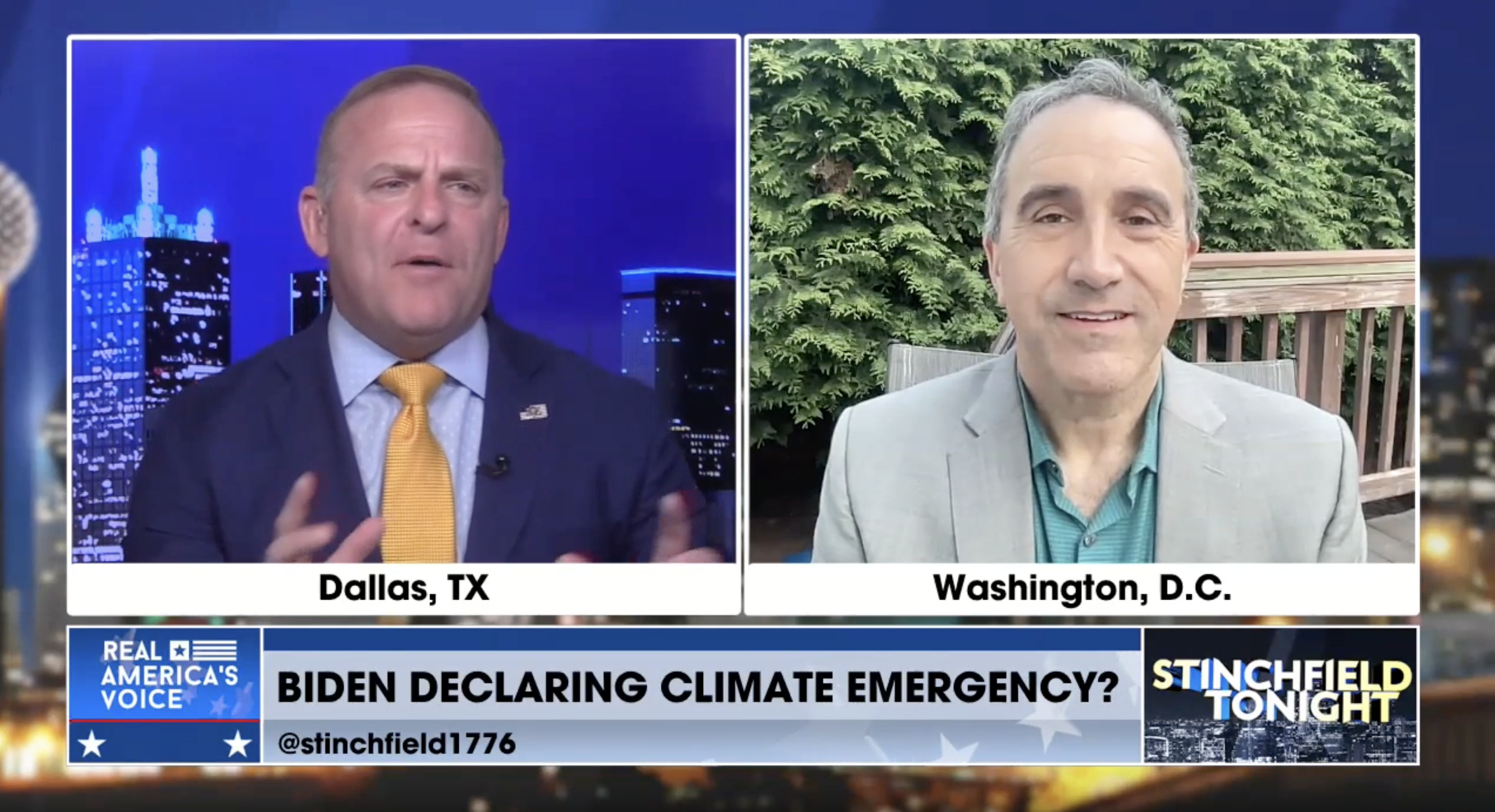https://www.cbsnews.com/news/climate-change-coronavirus-bats-study/
BY JEFF BERARDELLI
FEBRUARY 5, 2021 / 4:04 PM / CBS NEWS
Human-caused climate change “may have played a key role” in the coronavirus pandemic. That’s the conclusion of a new study which examined how changes in climate have transformed the forests of Southeast Asia, resulting in an explosion of bat species in the region.
The researchers found that, due to changes in vegetation over the past 100 years, an additional 40 species of bat have moved into the region, carrying with them 100 more types of bat-borne coronaviruses. Bats are known carriers of coronaviruses, with various species carrying thousands of different types. Many scientists believe the virus that started the worldwide COVID-19 pandemic originated in bats in southern China’s Yunnan province or neighboring areas before it crossed paths with humans.
These findings have scientists concerned about the probability that climate change will make future pandemics more likely.
“If bats carrying around 100 coronaviruses expanded into a new area due to climate change, then it would seem likely that this increases, rather than decreases, the chance that a coronavirus harmful to humans is present, transmitted, or evolves in this area,” explains Dr. Robert Beyer, lead author of the study and a researcher at the University of Cambridge.
The researchers used climate records to create a map of the world’s vegetation as it was a century ago. Using knowledge of the type of vegetation required by different bat species, they determined the global distribution of each species in the early 1900s.
They then compared this to current bat populations. Their results reveal that bat species richness — the number of different bat species found in a given area —has flourished in this pocket of Southeast Asia more than any other place on Earth.
Kate Jones, a professor of ecology and biodiversity at University College London, is also somewhat cautious. She said, “Climate change certainly has a role to play in changing species distributions to increase ecological hazard. However, spillover risk is a complex interplay of not only ecological hazard but human exposure and vulnerability.”
Beyer does agree that “caution is well-justified” when it comes to connecting climate change directly to the pandemic because, as he explains, assessing the degree to which climate change contributed to any stage between a bat carrying the virus and a human getting infected will take a lot more work. In particular, he says, this involves the use of epidemiological models that analyze the interactions of different species and viruses across space and time.
While it’s widely understood that exponential growth of the human population, and our rampant exploitation of the natural world, like destroying forests and expanding the animal trade, is increasing the risk that contagious pathogens can more easily make the jump from animals to humans, it has been less clear the extent to which climate change factors in.
“Climate change definitely is an important driver in disease emergence and spread. It can increase transmission in a number of ways,” said Ostfeld. “So, yes, climate change definitely concerns me as a driver of future pandemics.”
Beyer also sees climate connections beyond just the increase in bat species. “In some cases, higher temperatures can increase the viral load in species, which can make it more likely that the virus is transmitted,” he said. “And: Increased temperature can increase the tolerance of viruses to heat, which in turn can increase infection rates since one of our primary defense systems to infectious diseases is to raise our body temperature (fever).”
#
Related:
MICHAEL CRICHTON, “ALIENS CAUSE GLOBAL WARMING” AT CALIFORNIA INSTITUTE OF TECHNOLOGY, PASADENA, CA (JANUARY 17, 2003) – Crichton: “This is not the way science is done, it is the way products are sold.”
John Kerry on coronavirus & climate change: ‘The parallels are screaming at us’ – ‘Cost of climate inaction will match — if not exceed — our current expenditures’– “Climate change is a threat multiplier for pandemic diseases, and zoonotic diseases — 70 percent of all human infections — are impacted by climate change and its effect on animal migration and habitats.”
Rolling Stone article: “How Climate Change Is Ushering in a New Pandemic Era” – “A warming world is expanding the range of deadly diseases and risking an explosion of new zoonotic pathogens from the likes of bats, mosquitoes, and ticks.” The article is long on assertions, touching anecdotes, and personal stories but short on facts and scientific evidence.

You have been warned: ‘A merging of the COVID climate issue’ is underway – Morano: “All the same solutions to COVID-19 were what the climate activists wanted: Destroying industrial activities, lowering emissions, destroying airline industry,stopping people from traveling, & essentially doing planned recessions through lockdowns.” https://onenewsnow.com/science-tech/2020/12/04/covids-left-climate-activists-feeling-forgotten
“There is going to be a merging of the COVID climate issue. The UN is on record, John Kerry is on record claiming because we’re not taking care of nature that we’re getting new viruses from the animal world & we have to prevent more viruses by fighting climate change.”
Morano: UN Sec General Guterres, the former president of Socialist International, is not about the science and or the environment. “He is about his political agenda and his own ideology, which is imposing this sort of central planning on the world using an ecological scare.”
Science Crushes Rolling Stone’s Claimed Link Between COVID & Climate – Rolling Stone falsely asserting a connection between climate change and COVID-19. In reality, if a modestly warming Earth has any impact on viruses and pandemics, it is to make them less likely and less severe…Historically, we know that the Black Plague arose and ran rampant in Europe and elsewhere during the Little Ice Age.
In the article, “How Climate Change Is Ushering in a New Pandemic Era,” the author writes, “[a] warming world is expanding the range of deadly diseases and risking an explosion of new zoonotic pathogens from the likes of bats, mosquitoes, and ticks.” The article is long on assertions, touching anecdotes, and personal stories but short on facts and scientific evidence.
CLAIM: ‘The coronavirus outbreak is part of the climate crisis’ – Claim: The two emergencies are in fact quite similar. Both have their roots in the world’s current economic model – that of the pursuit of infinite growth at the expense of the environment on which our survival depends – and both are deadly and disruptive. In fact, one may argue that the pandemic is part of climate change and therefore, our response to it should not be limited to containing the spread of the virus. What we thought was “normal” before the pandemic was already a crisis and so returning to it cannot be an option. …
The rapid response to COVID-19 around the world illustrates the remarkable capacity of society to put the emergency brake on “business-as-usual” simply by acting in the moment. It shows that we can take radical action if we want to.




